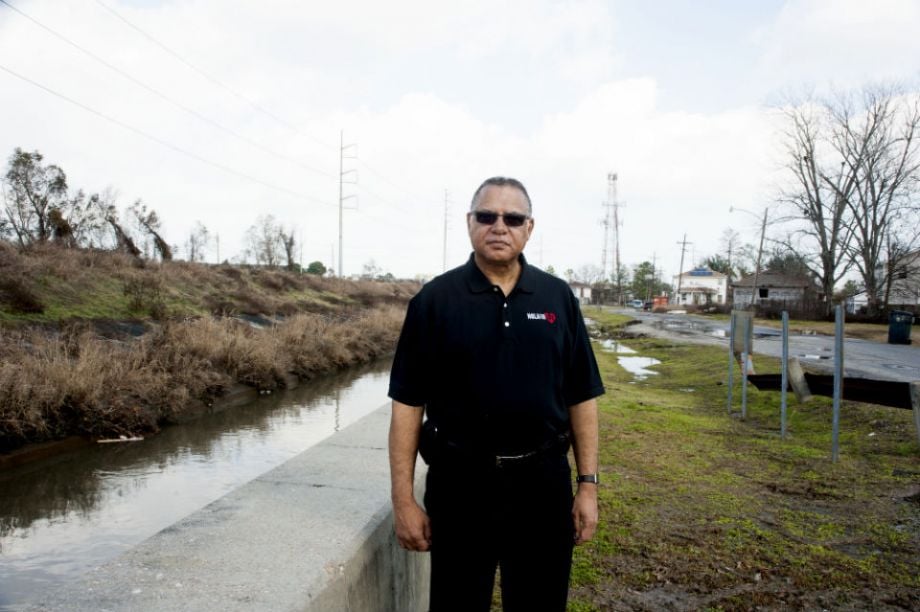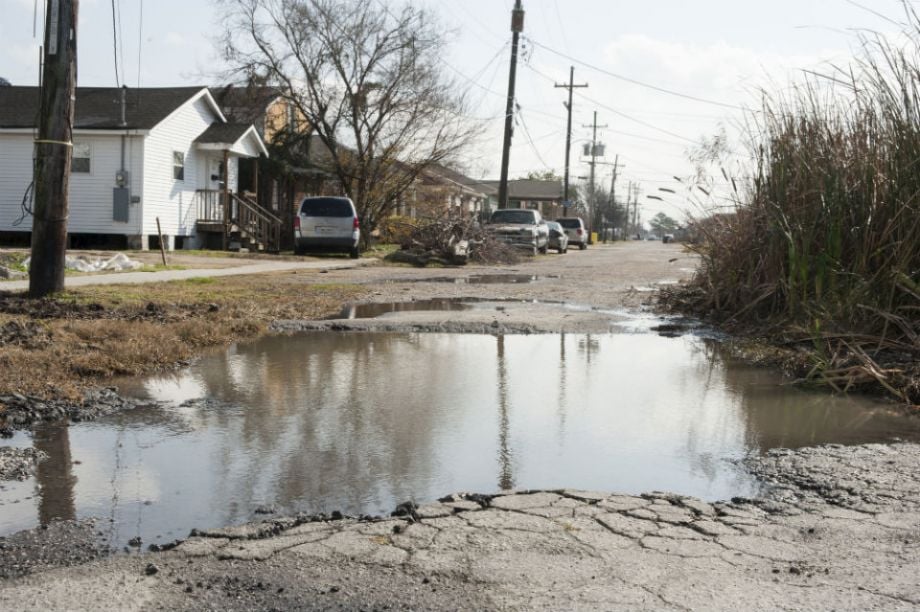Are You A Vanguard? Applications Now Open
This is your first of three free stories this month. Become a free or sustaining member to read unlimited articles, webinars and ebooks.
Become A MemberCedric Grant can remember the day when crews finally paved the New Orleans street where he grew up. Grant, now 61 and the city’s deputy mayor of infrastructure, was in high school when the improvements happened in the Hollygrove neighborhood, where stormwater flooding and standing water after heavy rains were an unwelcome part of everyday life. “There were ditches,” Grant says. “My mother didn’t think that was a good thing.”
Then the paving trucks came. Where there had always been a dirt surface, with gullies running alongside that filled up when it rained, municipal workers poured asphalt. This relatively simple application of infrastructure all at once transformed Hollygrove Street into the picture of modernity, bringing this little corner of New Orleans into the 20th century. It looked like a neat and tidy solution, but time has proven its weakness.
For generations the city has been doing a dangerous dance with water, a give-and-take that has more than once turned deadly. Now, the stakes are higher than ever. Like many other coastal cities, New Orleans faces a potentially catastrophic future as the climate changes and sea levels rise. It already receives more than five feet of rainfall each year, making it one of the three wettest cities in the nation, and the intensity and frequency of rainfall events have steadily increased. Intensive management of the Mississippi River has led to the erosion of protective wetlands in the river’s delta. The Louisiana coastline loses about 75 square kilometers every year, dramatically increasing New Orleans’ exposure to surges during hurricanes. And the practice of pumping stormwater out of the bowl in which the city sits has caused the ground to dry out and subside. The water is rising, and the land is sinking.
Hurricane Katrina may well have been the proverbial perfect storm that attacked all of these weaknesses simultaneously, but it won’t be the last. New Orleans, with a huge infusion of federal money, has already reinforced the levee system that failed during the storm. Levees, however, won’t be enough, and the city is looking to move its water management into the 21st century.
Its plan for doing so was developed over two years at a cost of $2.5 million, funded by a federal disaster recovery grant administered by Greater New Orleans, Inc., an economic development alliance. The Greater New Orleans Urban Water Plan, released last September, would mean a reversal of what looked like progress to Grant’s mother and so many others. It may also mean that New Orleans will continue to be a viable city for generations to come.
The plan calls for water to be reintegrated into the surface of the city, this time in small ponds or canals, rather than being sucked up and pumped away. It envisions a comprehensive system of green infrastructure such as bioswales, rain gardens and permeable pavement to replace old pipes, drainage systems and buckling streets, many of which are still marked with damage from Katrina.
There is much repair to be done. Potholes deep enough to fit a small child pit city streets. The sewage system loses an estimated 90 million gallons of drinking water every day due to leaking pipes. Pipes rupture altogether on a disturbingly regular basis, leading to flooding, low water pressure and “boil water” advisories that disrupt the lives of tens of thousands of people at a time. Troublingly, this is the status quo after hundreds of millions of dollars in recovery grants were spent to repave and repair Katrina-damaged roads and sewers.
If New Orleans is to survive another hundred years, according to the architects of the water plan, it will have to start looking to the past to reshape the present. It will have to stop focusing on pavement and pipe — so-called gray infrastructure — and start imagining a New Orleans in which water is an acknowledged presence, an invited if somewhat difficult guest.
The discussion about how best to do that has been ongoing ever since Katrina hit in 2005. In the catastrophe’s wake, local architect David Waggonner initiated a series of discussions called the Dutch Dialogues, which have deeply informed the city’s new water plan. Waggonner, who had traveled to the Netherlands with U.S. Sen. Mary Landrieu on a post-storm educational mission, become convinced that New Orleans could become a laboratory for best practices in water management. With others, he brought in experts from Holland to learn how New Orleans could adapt that country’s state-of-the-art approach toward “living with water” to local conditions — and then take it to the next level.
The Dutch have adopted the idea of living with water because, in the last 40 years, it became clear that the old approach of keeping water out, the basis of the nation’s design and even its political structure, wasn’t going to work any longer. So the land of dikes and seawalls and other hard-engineered solutions has embraced a new type of engineering. Parks and parking garages are built to safely accommodate floodwaters and then allow for their gradual dispersal. Green drainage systems that allow water to percolate into the earth slowly are incorporated into all new construction projects and repairs of the old. Floating buildings rise and fall with the tide. Reservoirs are reimagined as recreational landscapes. Every detail is reimagined to allow for the presence of water on a temporary or permanent basis.
Waggonner says that when he and his colleagues created demonstration designs, such as “floating streets” envisioned for the Lakeview neighborhood, they were thinking in the Dutch way. A casual observer might look at one level of the rendering and see a street lined with grass and a ditch, not much different from the ones that plagued Cedric Grant’s mother. But beneath this unassuming surface, an ingenious if relatively simple system is accommodating the water safely and in a way that complements the ecosystem. “It’s engineered,” Waggonner says. “The Dutch get excited about a pipe or a flap, but these are the kind of modest moves that make this work.”
“Detain, infiltrate in the ground, and filter,” says landscape architect Dana Brown, who has been involved in the water plan since the early days. “That’s the holy trinity of water management.”

In Hurricane Katrina’s wake, local architect David Waggonner initiated a series of discussions called the Dutch Dialogues.
Everyone involved in the Dutch Dialogues process and the creation of the water plan is keenly aware of how long it took to get to this point — of how many conversations, recommendations and meetings were involved. They say the next step of moving the plan into action must happen faster.
“The dialogues were intended to inspire people to think differently about solutions,” says Dale Morris, a senior economist at the Royal Netherlands Embassy in Washington, D.C. “Now it’s time to implement. Something needs to happen.”
The cost of sticking with the status quo, advocates say, is dire. If New Orleans doesn’t change its ways and let the water in, then the water will bust down the door. Who knows what it will wreck when it finally gains entry?
But implementation won’t come cheap. The price tag for the projects advanced in the plan is a whopping $6.2 billion, in a place where voters, jaded from a long history of government corruption and incompetence, question even the smallest tax. The plan’s boosters, who say it would create $22 billion in value over the next 50 years by preventing flooding, raising property values and spurring economic development, point out that funding mechanisms for each component have been identified. The sources eyed by the plan’s architects include federal money from FEMA and HUD, state dollars from the Coastal Development and Protection Authority and other sources, public-private partnerships, and possible future stormwater impact fees that could be assessed from property owners with impervious landscaping that creates runoff. None of this money is locked down yet, however, and many people are skeptical.
Jeffrey Thomas is a consultant who worked inside New Orleans city government on long-term disaster recovery between 2007 and 2009. In 2012 he coordinated a business-citizen task force that studied how to reform the city’s stormwater and sewage management. What he sees when he looks at the water plan’s beautiful renderings, and the iPad app created to promote it, is a cultural gap the city needs to bridge before systematic implementation can begin.
“This is typical when you have an aspirational planning process that then has to be met with government implementation,” Thomas says. “For that planning document to be realized, government has to act. There are three major types of action that local government has to do: First, engineer water management into our public space — our parks, our streets, our neutral grounds. These designs have to reflect the fact that we live in a sinking bowl subject to incredible amounts of rain. Secondly, we have to have a budget plan that earmarks money specifically for building and maintaining these projects. Finally, we have to have a policy action plan. It’s not enough to do this only in the public domain. We have to mandate or incentivize these same management features in private residential and commercial developments. That’s what has to happen for this aspirational water plan to become real. Otherwise, it’s just a collection of beautiful renderings.”

“We need an education process for folks who have been here for generations,” says Cedric Grant, deputy mayor of infrastructure for New Orleans.
Grant, who still can recall his mother’s pleasure at seeing those ditches paved over, knows that the plan will not be an easy sell. Lots of New Orleanians hear the word “ditch” or “wetlands” and think of mosquitoes and pestilence. Repeated epidemics of yellow fever killed more than 41,000 of the city’s people between 1817 and 1905, and that specter still haunts the streets. So, too, does the idea that only by pumping every drop of water out of the city can New Orleans remain safe from drowning. The challenge now is to convince residents and leaders that aggressive investment in green infrastructure — rain gardens, detention ponds, bioswales, porous pavement and the like — is the way forward for a perennially cash-strapped, tradition-bound New Orleans.
“We need an education process for folks who have been here for generations,” Grant says. He insists he is optimistic, in part because of the most recent watery tragedy the city endured. “There’s much more engagement for everyone post-Katrina, period,” Grant says. “We survived life or death… For 300 years we’ve had to struggle through everything, and now it’s just this generation’s turn.”
For all of those 300 years, New Orleans has strategized about, fortified against and bargained with water — the Mississippi, the surrounding wetlands and the intermittent deluges from the sky. It has had to. Water is the only reason New Orleans exists, after all.
The city’s port, along with the adjacent port of South Louisiana in the suburb of LaPlace, together make up the biggest cargo port in the U.S. and the 12th biggest in the world. Water is the reason the nation could not abandon New Orleans after Katrina. Not Bourbon Street tourism, not nostalgia for wrought-iron balconies and Spanish moss, not altruism, but water — and the billions of dollars in commerce that it moves.
New Orleans has always been about water. In 1718, the French chose to build a settlement on a bit of slightly higher land at this swampy bend in the river, because it was convenient to trade routes. But it had few other natural advantages. The standing water all around bred malaria and yellow fever, and the threat of hurricanes was with the city from the very year it was declared France’s capital in the Americas, 1722. That November, a storm coming in off the Gulf of Mexico destroyed nearly every building that had been erected.
But the people who wanted New Orleans to thrive were determined, and they saw from the beginning that money could be made to flow through this damp and feverish place at a rate that could rival that of the Mississippi itself. Rational engineering was the answer to the city’s problems, its builders decreed. So they laid out streets in straight lines, dug canals and raised levees ever higher to keep the willful river in its channel.
If New Orleans is to survive another hundred years, according to the architects of the water plan, it will have to start looking to the past to reshape the present.
At times, the engineered solutions failed utterly. In 1849, for instance, the city was overcome by water from the Mississippi when the levee ruptured at a plantation 17 miles upriver, unleashing a flow that inexorably inundated 220 acres of inhabited land — all the way up to fashionable Magazine Street — as well as countless more square miles of swampland, most of which has been drained and developed today. Some 12,000 people were left homeless in the aftermath. Finally, engineers came to the rescue once again, closing the crevasse upriver after weeks of labor and stemming the Mississippi’s natural inclination to consume the very delta it had created.
The city at once implemented a tax to fund rebuilding, and rebuild it did. The importance of New Orleans as an economic engine — where the trade in sugar, slaves, cotton, furs, feathers and bananas made a few men very, very rich indeed — only grew.
As did the levees. From the early years of the 19th century, the problem of flooding on the Mississippi — how to handle it, prevent it, contain it — had been a challenge that attracted some of the nation’s brightest minds. Brilliant men spent years studying the river, as chronicled in John Barry’s superb book about the flood of 1927, Rising Tide. One even devised a diving suit that allowed him to walk around on the silty bottom, 200 feet down, with the water surging past him at hundreds of thousands of cubic feet per second.
Problem was, all these engineers came up with radically different solutions for a river that, if left to its own devices, would regularly break its banks and consume all the hard-built works of man. Some said levees-only was the way to go. Others argued for a combination of levees and spillways that would take pressure off the earthen walls that contained the river.

When it rains, flooded streets are a regular sight in New Orleans.
In the end, a maddeningly complex system of levees, floodgates, spillways, canals, pumps and dams was cobbled together, as the competing geniuses gained control one after the other. New Orleans itself, which ranges in elevation from a few feet above sea level to a few feet below, was ringed around with levees. It had become, in effect, a bowl that collected rainwater. And the city gets more than 60 inches of rain in an average year, with several inches sometimes falling in just a few hours.
Getting that water out of town was yet another engineering challenge, met in this case by a man named Albert Baldwin Wood. A native son of the city and a graduate of Tulane, Wood went to work for the Sewerage and Water Board of New Orleans in 1899. The SWBNO is a uniquely important agency. Perhaps no other water authority in the country exerts as much control over the lives of a city’s people. It was a fine place for an ambitious young man to work.
The problem Wood set out to solve was a problem not of the Mississippi itself, nor even of hurricanes per se. It was the problem of the rain-collecting bowl. In 1913, Wood invented a screw pump that, once he perfected it after a couple of years of trial and error, could move water out of the city and up into Lake Pontchartrain at an astonishing 1,000 cubic feet per second. The design was ultimately exported around the world, to Egypt, Japan and, in an ironic prelude to the Dutch Dialogues of the post-Katrina era, to the Netherlands.
Wood’s pumps enabled a vast expansion of the settled land in New Orleans. Within a mere two years of their invention, 25,000 acres of previously uninhabitable swampland had been drained for development. But pumping all that water out, for a century now, has had an unexpected and negative effect on the very streets it enabled. The unstable mixture of clay, muck and sand that underlies New Orleans needs water to remain stable. Pumping out the water has dried out the land, and many experts agree that has caused the city to sink yet further and the asphalt carapace is not enough to hold back floodwater when it rains.
“The runoff is coming back to you,” Waggonner says. “The thing that was poured and flat is subsiding and breaking. There’s an underlying problem, but we can’t get to it because we’ve capped it.” Streets buckle, foundations shift, cracks appear in the roadway, and the bowl that disastrously filled with floodwater during Hurricane Katrina gets ever deeper.
Following Katrina, the city spent tens of millions of federal relief dollars on road repair through the Louisiana Submerged Roads Program, but that money went almost entirely to conventional repairs. A small test project in the Lower Ninth Ward using permeable concrete to repave streets was an exception.
That’s the kind of disconnect between the ideals of the water plan and the reality of on-the-street engineering that Jeffrey Thomas says poses a significant challenge to the plan’s grand vision. He points out that in the city’s 2014 capital budget, there’s no mention of bioswales or pervious pavement.
“Look at the capital budget,” Thomas says. “How are we deciding to spend money in streets and public spaces? To what extent are any of [these new road projects] going to include pervious paving and bioswales? If we agree that this is needed, it should be in the capital budget.”
Thomas points to a plan for a huge new shopping center being built with help from tax -increment financing. It will have a huge and impervious parking lot, “In negotiating the TIF so far, there is no requirement as a matter of policy that the developers take runoff into consideration,” he says. “They actually are replacing grass with concrete.”
Many engineers within government, he says, are still not convinced of the efficacy of the Dutch style of water management. Moreover, there aren’t a lot of firms competing for city jobs that are equipped to work in this way. “What I see currently is aspirations and verbal decisions that have not yet translated into budget decisions and policy decisions,” Thomas says. “In the bureaucracy, there is skepticism. There are important questions of cost and feasibility. The bureaucracy is saying something, and we have to listen to it.”
David Waggoner is a slight man, with a soft voice and self-effacing demeanor. Thanks to his involvement with the Dutch Dialogues and the Greater New Orleans Urban Water Plan, though, his influence in the way the city thinks about reconfiguring the post-Katrina landscape is profound. His firm, Waggonner & Ball Architects, is also deeply involved with another coastal reconstruction project, the post-Sandy Rebuild by Design competition in the New York-New Jersey area.
Waggonner, 63, comes from Louisiana political royalty. His father, Joe, was a congressman from Bossier Parish, just up the river from New Orleans, for 18 years. The younger Waggonner, who trained as an architect at Yale, has spoken admiringly of his father. But his own worldview is one that looks away from typical political solutions, and he talks about the challenges facing New Orleans in a way that explicitly rejects conventional forms of power.
“The issues that politicians talk about, those aren’t the real issues of the voter,” Waggonner says. “Politics — that’s when I despair, because politics should support the best, but politics plays on what’s divisive.”
As an architect, Waggonner has built projects all over the world. But ask him nuts-and-bolts questions — about, say, garnering public support for the water plan, or the feasibility of reversing generations of poor engineering decisions, or the decades of corruption both perceived and proven in New Orleans — and the conversation quickly becomes abstract. This isn’t an attempt to evade such questions. It’s simply his characteristic way of thinking about and tackling the underlying problems.
“The discussion is at once practical and esoteric, and it needs to be,” Waggonner says. “The real questions that leaders need to be solving are much deeper than the daily chatter. How do we become relevant to our own time? Our inability to grasp where we are in history, our inability to grasp our mythic place and the forces impinging on ourselves, leads to catastrophe.”
The only way to mitigate that catastrophe, in Waggonner’s estimation, is to fundamentally shift the way we manage the intersection of the built environment and the natural environment. And New Orleans, he says, is the perfect place to do it. “This is a vital river delta,” he says. “Are we going to give up on it?”
“There’s much more engagement for everyone post-Katrina, period. We survived life or death… For 300 years we’ve had to struggle through everything, and now it’s just this generation’s turn.”
The plan’s architects imagine a New Orleans that not only deals with its own water problems gracefully and efficiently, but also serves as a model for other cities around the world. If the plan is executed as outlined, New Orleans will be able to serve as a sort of laboratory from all the most up-to-date thinking and design in stormwater management. These days, cities like Seattle and Philadelphia are on the cutting edge of green infrastructure treatment of water in the U.S. Plan backers in New Orleans want to put their city at the head of the class.
To that end, the water plan includes a number of demonstration projects that put “living with water” principles into action on a neighborhood scale. One of these is the Lakeview Floating Streets project, which calls for rebuilding buckling streets in a few square blocks near Lake Pontchartrain; paving them with pervious pavement; planting bioswales that will allow stormwater to percolate slowly into the underlying soil; bundling and burying utility lines; planting trees; and reconfiguring the street to allow for different modes of travel, including biking and walking. In significant downpours, this configuration would enable a “slow, store and drain” effect that would prevent the water from overwhelming the roadway or threatening homes.
Another, more high-profile demonstration project on the table is the “Lafitte Blueway,” a complete redevelopment of a strip of abandoned, derelict land connecting Lake Pontchartrain with the French Quarter. Where there are now fenced-off, abandoned industrial wastelands, the project envisions a linear park that focuses on an excavated waterway, complete with kayak launches, bike paths, playgrounds, community gardens and other amenities.
The benefits of the Blueway, according to planners, would not simply be environmental, but also economic. They envision it as creating a redevelopment corridor not unlike the one around New York’s High Line, or the area along the Chicago River. This economic angle is important because, again, none of this will come for free. Implementation of the plan as outlined would cost $6.2 billion, and while its backers say that financing options have been identified, the dollars have not yet been secured. Will it happen? “That’s the $6.2 billion question,” says Morris of the Royal Netherlands Embassy.
The SWBNO has proposed spending more than $723 million in 2014 on repairing its aging, dysfunctional system. Grant says that a revamped approach to handling water in the city could keep costs down in the long term, and points to a comprehensive zoning ordinance that requires developers to create better plans for retaining and managing water on the sites where they build. He says that individual homeowners can each play a role in managing the water on their properties with rain gardens and rain harvesting. Such measures may seem incremental, but Grant thinks they are vital.
“We can’t build our way out of this,” he says. “My question is, if we implement other things to where this water doesn’t get into the system, how much does that save? How much do we not have to build?”
In the water plan’s handsome iPad app, which guides users through problems and proposed solutions, the authors acknowledge the concern about funding with this statement: “There is no low cost option on the table. There is just high value, represented by the Water Plan, and low value represented by established methods.”
“Water is like life. You can see it, but you can’t grasp it. You can’t hold it. If we try to impose our will on these systems, we’ll fail.”
Mayor Mitch Landrieu, recently reelected to a second term, has been a strong supporter of the plan. “As we continue to rebuild our city, innovative water management strategies, including the Greater New Orleans Urban Water Plan, will be at the forefront,” he said in a press release when the plan was unveiled in September 2013. “We have an opportunity to create a template for water management that can serve as an international model for resiliency.”
Supporting the multibillion-dollar effort has perhaps been easier for Landrieu since the proposed funding streams would come mostly from the state and federal side, rather than the city tax streams that traditionally support infrastructure. If New Orleans did become an international leader in the field of water management, it would cement an identity he has pushed to create — the pragmatic yet progressive Louisianan technocrat. Even better, he hasn’t yet been asked to put much skin in the game.
Tony Lee has already put everything he has into solving his small part of the New Orleans water puzzle. Lee is a neighborhood linchpin who got help from Tulane City Center to improve his once-swampy community garden in the city’s Algiers section. Now the Magellan Street Garden is a model of best practices in water management, as well as a measure of how much one person can accomplish with sweat equity and persistence.
Cantaloupe and mustard greens thrive in the garden’s neatly planted rows. Lee sells some to restaurants, but he’ll give food to anyone from the community who needs it. During a storm, rain cascades from the roof of a structure that provides shade in sunny weather and into a series of sparkling pools fringed by native vegetation. The clean water has attracted turtles and frogs, which help keep the mosquito population under control.
Before the renovation, Lee says, a heavy rainfall would mean flooding that rendered parts of his small plot of land unusable. Now, it’s a welcome event. “When it rains,” he says, “it’s so beautiful to watch.”

When it storms, rain flows cascades off Tony Lee’s roof and into his raised beds of vegetables.
For Waggonner, that simple appreciation of and connection to the natural world would be a key benefit of a fully implemented water plan.
“In the evening, the sound of crickets or frogs will bring you to awareness,” he says, before going on to muse about the way that water can focus our attention on the problems at hand. “Thinking about water is about the only way we’re going to heal ourselves,” he says. “Water is like life. You can see it, but you can’t grasp it. You can’t hold it. If we try to impose our will on these systems, we’ll fail.”
For Morris, the work happening in New Orleans represents an opportunity to model adaptation and mitigation strategies that can be used in cities around the world — and not a moment too soon. He says it’s no coincidence that many of the same people who have been thinking about how to make post-Katrina New Orleans into a more sustainable city have now shown up in New York and New Jersey to come up with solutions to post-Sandy challenges.
“The changing climate may or may not be a problem for all places, but it clearly is for coastal areas,” he says. “Human lives and capital are at risk. We need to abandon our focus on single-purpose infrastructure.”
For Waggonner as a practitioner, it’s the chance of a lifetime to push the envelope of what’s possible, right in his hometown. Yes, he concedes, New Orleans is a complicated place. History, nostalgia, race and class weigh heavily here. The natural forces at work can at times seem overwhelming. So many mistakes have been made here, all in the name of progress.
That seems to only increase his appetite for the job at hand. “That’s why you need New Orleans,” Waggonner says. “You need to test what you can do here, where it’s hard. We have to commit to some test. I’m an architect. I think in space. This is a good test.”
Our features are made possible with generous support from The Ford Foundation.

Sarah Goodyear has written about cities for a variety of publications, including CityLab, Grist and Streetsblog. She lives in Brooklyn.

Akasha Rabut is a freelance photographer based in New Orleans. After a childhood living between Kauai and California, she studied photography at Otis Parsons College of Art and Design and San Francisco Art Institute. In 2007, she graduated summa cum laude from SFAI. Akasha’s work has appeared on the pages and websites of various publications including Vice, Beautiful Decay, Stopsmiling.com, Design For Mankind, Fecalface.com, Milkmade.com and Notcommonpeople.com. She is a member of the photography department at The Historic New Orleans Collection.

20th Anniversary Solutions of the Year magazine